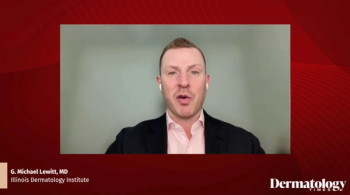
- Dermatology Times, August 2022 (Vol. 43. No. 8)
- Volume 43
- Issue 8
Diagnostic Approaches for Melasma and Vitiligo
Pigmentary disorders of the skin can be the cause of significant psychological distress in affected patients.
Whether caused by hyperpigmentation or hypopigmentation, pigmentary disorders such as melasma or vitiligo can be very challenging to treat and many patients often suffer from the negative psychosocial impact and significantly decreased quality of life associated with the many different forms of dyspigmentation of the skin. According to Seemal R. Desai, MD, a leading expert in skin of color and disorders of pigmentation, an acute knowledge of the diagnostic dilemmas, cutting-edge treatment options, and latest clinical research regarding the diagnosis and management of pigmentary disorders is par-amount and requisite to finding the optimal treatment and management plan in affected patients.
Skin color is influenced by the density or concentration of melanocytes; the number, size, and dispersion of melanosomes; and the nature of the pigment and its rate of degradation. Having a myriad of etiologies, the heterogenous group of pigmentary disorders includes hyperpigmented disorders such as melanosis or melasma, postinflammatory hyperpigmentation, drug-induced hyperpigmentation, solar lentigines, ephelides, café-au-lait macules, nevi, and melanoma and its precursors, as well as hypopigmented conditions, the most common of which include vitiligo followed by pityriasis alba, tinea versicolor, and postinflammatory hypopigmentation.
“Whenever approaching patients with skin of color, it is important to understand that no single therapy exists to achieve the perfect balance of skin lightening and maintaining cutaneous integrity. This mantra is most relevant in the treatment of hyperpigmentation, including melasma, postinflammatory pigmentary alteration, drug-induced causes, or other etiologies. The bottom line is that it is important to keep an open mind regarding a multi-therapy approach, possibly involving office-based procedures and/or newer more literature-based treatment modalities,” said Seemal R. Desai, MD, FAAD, clinical assistant professor, Department of Dermatology, University of Texas Southwestern Medical Center, Dallas, Texas, who recently spoke at the Maui Derm NP+PA Summer 2022 conference.
Hyperpigmentation may be localized or diffuse in its presentation and is characterized by the darkening of an area of the skin caused by the overproduction of melanin, which can result from increased production of melanin pigment, or pigmentary incontinence, an accumulation of a large number of melanocytes, and deposition of other non-melanin pigments or substances in the skin.
MELASMA
The most common hyperpigmentation disorder presenting in the dermatology practice is melasma, an acquired hypermelanosis of the skin seen predominantly in females with darker skin types and occurring most often on sun-exposed areas, mostly on the face and occasionally on the neck and forearms. With a still unclear pathogeny, melasma is an incurable condition that can be triggered by several factors, including sun exposure; genetic influences; pregnancy; sexual hormones; inflammatory processes in the skin; or use of cosmetics, steroids, or photosensitizing drugs. Many treatment options are available to clinicians, including topical retinoids, topical corticosteroids, azelaic acid, hydroquinone, chemical peels, cosmeceuticals, lasers, and dermabrasion, as well as a combination of these treatment modalities. Although melasma can be managed well with these treatment approaches, it can often recur or may never fully clear with current therapies.
According to Desai3, the only FDA-approved combination branded formulation that can be used for melasma is Tri-Luma cream (Galderma Laboratories, LP), which has a concentration consisting of hydroquinone 4%, tretinoin 0.05%, and fluocinolone acetonide 0.01%. While hydro-quinone interrupts the formation and synthesis of melanin to help lighten the skin, tretinoin increases the skin cell turnover rate to help exfoliate the skin, and the corticosteroid helps reduce inflammation in the target area.
“Typically, my personal workhorse compound therapy for melasma has been a hydroquinone-based triple combination lightening therapy consisting of hydroquinone ranging from 4% to 6%, tretinoin 0.025%, and dexamethasone 0.1%. Although used off label, in my experience this combination therapy has worked very well to help lighten the targeted skin in my melasma patients,” Desai said.
After taking standardized baseline photographic images, Desai will often use hydroquinone-based triple combination therapy for about 12 weeks in his melasma patients and, importantly, will always avoid prescribing unlimited refills for treatment. When patients follow up after the treatment course and appear to be doing better, Desai will switch them to a non–hydroquinone-based product to maintain the improvements achieved.
Although there have been multiple studies on the safety of hydroquinone, Desai does not consider the medication to be carcinogenic because of the paucity of substantial evidence in randomized, double-blinded, placebo-controlled trials. Nevertheless, caution is advised as patients should not use the medication ad infinitum. According to Desai, hydroquinone has some limitations because it can cause exogenous ochronosis and can sometimes be irritating, necessitating its use in lower concentrations and for a limited amount of time.
“Once some therapeutic success is achieved, we try to keep patients off hydroquinone for as long as we can and only go back to the medication when it is absolutely necessary. Hydroquinone is very effective in melasma; however, it should only be employed in the periods where you really need it,” Desai said.
Certainly, it can be challenging for patients to apply the medication correctly to gain the maximum benefit of treatment. As such, clinicians must consult and educate their patients appropriately in terms of precisely where and how to apply the medication effectively, including applying small amounts strictly on hyperpigmented lesions and in thin layers.
Regardless of the chosen treatment modality, Desai will very frequently advise his melasma patients to regularly use broad-spectrum sunscreens as well as topical antioxidants, such as vitamin C, throughout the treatment course. Other treatments that have shown good efficacy in melasma include chemical peels, such as azelaic acid in 15% to 20% concentrations applied twice a day and tranexamic acid com-pounded in a 3% concentration. In 1 study1, it was shown that tranexamic acid controls pigmentation by inhibiting the release of inflammatory mediators, specifically, prostaglandins and arachidonic acid, which are involved in melanogenesis, and the most effective dosing appears to be 500 mg daily, whether in topical, oral, or intra-dermal form. However, caution is advised for orally administered tranexamic acid as contraindications for the medication include current and past clotting episodes such as deep vein thrombosis and pulmonary embolism. Tranexamic acid is not FDA approved in any form for melasma or a skin indication.
VITILIGO
On the opposite end of the spectrum, vitiligo represents the most frequently seen depigmentation disorder in the dermatology practice. Often dismissed as just a cosmetic issue, the common autoimmune depigmenting skin dis-ease typically presents as non-scaly, well-circumscribed, chalky-white macules and patches that can occur anywhere on the body, causing devastating psychological distress and social stigmatization, particularly in patients with darker Fitzpatrick skin types. It is the progressive destruction of the melanocytes in the skin that invariably results in the appearance of patchy depigmentation.
Whether presenting with unstable, chronic, or refractory disease, vitiligo remains very challenging to treat. Newer vitiligo subtypes have also recently been recognized, including confetti-like depigmentation (potentially indicating rapidly progressing vitiligo) and trichrome vitiligo (a variant of active vitiligo). The distinction between the variants is crucial as the currently available treatment and management options as well as prognosis differ according to variant type.
Depending on the variant, clinicians have a mosaic of treatment options at their disposal, including topical corticosteroids, vitamin D analogues, calcineurin inhibitors, depigmentation, systemic therapies, phototherapy, and surgical treatment. According to Desai however, recent research with Janus kinase (JAK) inhibitors, however, has brought much-needed hope to this patient population.
“This is a very exciting time for vitiligo patients because we now have the JAK inhibitors, which appear to be very effective in addressing the disease in preliminary trials, showing significant improvements in repigmentation. Ruxolitinib 1.5% cream (Opzelura; Incyte), in particular, has shown to be very effective in improving symptoms, and the medication is now FDA approved. This is a very exciting therapy that can now be added to our armamentarium for our vitiligo patients,” Desai said.
Even though ruxolitinib is applied topically, treatment with the novel JAK inhibitor is still not without risk and patients need to be well informed of the potential adverse events. Vitiligo patients are nevertheless very open to the new medication, Desai said, as other tried-and-failed therapies leave them with a sense of hopelessness, making them eager to try a new medication that appears to be relatively safe while showing good efficacy in trials so far.
Antioxidants, oral therapies, laser and light therapies, and the topical JAK inhibitors can be used in combination and, according to Desai, many patients are very excited to try out new treatments and combination therapies simply because of the significant frustration and psy-chological burden associated with their disease.
“Many patients see their physician and can get easily frustrated after failing any number of therapies. Nevertheless, they need to be educated and well informed that there are evolving treatments that are proving to be effective, and it is the clinical path that patients and their physicians must travel together in search of the right treatment plan that works for their individual case,” Desai said.
Unfortunately, relapses are not uncommon and Desai said tacrolimus 0.1% cream can help stabilize the disease. According to Desai, many times one can reduce the risk of relapse to about 10% of repigmentation by applying tacrolimus ointment twice weekly as a pulse monotherapy, as was recently shown in a study by Cavalié et al.2
“Relapses are not a doomed failure of treatment, but instead should be simply viewed as a setback, a common occurrence in inflammatory diseases such as vitiligo. Should a relapse occur, the key is not to panic because they can be managed, as we have many different treatment options to quell symptoms. The ‘right’ therapeutic regimen just needs to be found for the individual patient,” Desai said.
References:
1. Tse TW, Hui E. Tranexamic acid: an important adjuvant in the treatment of melasma. J Cosmet Dermatol. 2013;12(1):57- 66.doi:10.1111/ jocd.12026
2. Cavalié M, Ezzedine K, Fontas E, et al. Maintenance therapy of adult vitiligo with 0.1% tacrolimus ointment: a randomized, double blind, placebo-controlled study. J Invest Dermatol. 2015;135(4):970-974. doi:10.1038/jid.2014.527
3. Desai S. Disorders of pigmentation. Presented at: Maui Derm NP+PA Summer 2022; June 23-25, 2022, Colorado Springs, Colorado.
Disclosures:
Desai is a consultant for Galderma Laboratories, Almirall, Ferndale Laboratories, Gore Range Capital, Bristol Myers Squibb, AbbVie, Verrica Pharmaceuticals, UCB, and Ortho; is a speaker for Pfizer; is a board member or executive for the Foundation for Research and Education of Dermatology, Dermavant Sciences, and the Women’s Dermatologic Society; does contracted research for AbbVie, Incyte Corporation, Dermavant Sciences, and AOBiome; has ownership interest in Gore Range Capital; and has another financial relationship with the National Psoriasis Foundation.
Articles in this issue
over 3 years ago
When to Progress to Systemic Therapyover 3 years ago
Focusing on Feetover 3 years ago
He Is my Covering Physician. Why Am I Being Sued?over 3 years ago
Mouse Model May Shed Light on APC mutations in brain metastasesover 3 years ago
FDA Approves Roflumilast Cream 0.3% for Plaque Psoriasisover 3 years ago
How to Tackle Challenging Cases in DermatologyNewsletter
Like what you’re reading? Subscribe to Dermatology Times for weekly updates on therapies, innovations, and real-world practice tips.

















